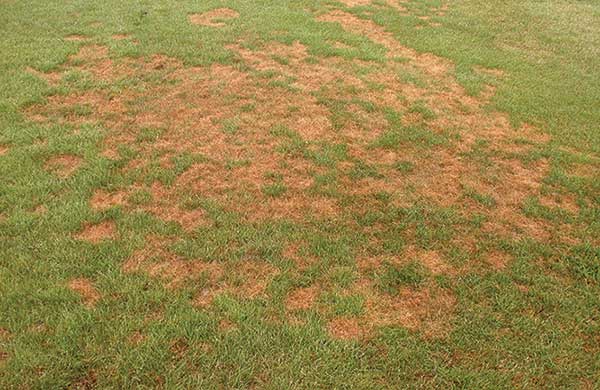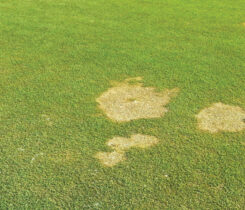Beating Pythium on ryegrass fairways
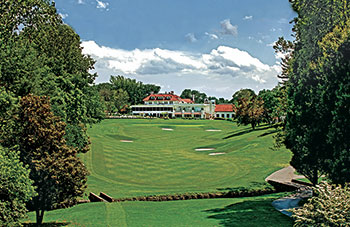
A shot of the picturesque fairway on No. 18 at Columbia CC. (Photo: Columbia CC)
If your short game is working and your long game is on, odds are you are going to have a successful round. The same holds for disease control. If one mode of operation is working well and a second can be added for more broad control, diseases don’t stand a chance.
That is why the team at Columbia Country Club, Chevy Chase, Md., relies on Segway SC from PBI-Gordon for disease control.
Columbia CC was founded in 1898, and the club’s long history is both a source of pride to Superintendent Stephen G. McCormick and a sterling reputation burden to uphold. Every one of the 18 holes must be immaculate and offer players spectacular conditions.
The club’s go-to fungicide program is Segway mixed with Primo and spoon-fed liquid nitrogen. It protects against Pythium over a period of 14 to 21 days. McCormick sticks to the label timing. He has no desire to stretch it out to see how long the activity would continue. “There is too much disease pressure to risk doing so,” he says.
Last year, weather was a challenge. It was much wetter than average, although the area experienced near-average temperatures. In addition to Pythium, McCormick was monitoring fairways for gray leaf spot and brown patch.
If it’s not one thing, it’s another. That’s why superintendents always look for new tools to control disease, and why McCormick attended a PBI-Gordon focus group discussing a new material that should have EPA registration sometime in mid- to late 2019. “To combat disease-resistance issues, I’m always intrigued by and try to use new chemistries as they become available,” he says.
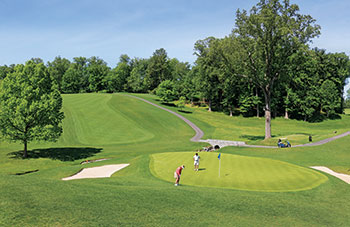
Columbia Country Club still maintains pristine ryegrass fairways and Poa annua greens, such as those here on the 350-yard No. 2. (Photo: Columbia CC)
McCormick recently heard about a new material called Union, another product developed by PBI-Gordon. Union is designed as a preventive and curative treatment of Pythium diseases (blight, damping off, root dysfunction, root rot), brown patch, anthracnose, cool-weather brown patch, yellow patch, fairy ring, gray leaf spot, red thread, summer patch and Rhizoctonia. Union is not yet available for sale or distribution.
McCormick already was a big fan of PBI-Gordon’s Segway fungicide for Pythium control. Segway is the brand name for cyazofamid, a FRAC 21 chemistry product. Its mode of action basically stops spores from germinating. This preventively inhibits all stages of Pythium fungal development.
“We are very happy with the results,” he said. “Despite record-setting summer rainfall totals, we saw no breakthrough of Pythium.”
If one solid punch is good, a one-two punch just might be better. A flowable liquid, Union is designed to be that second punch against Pythium. Its label is expected to allow application at 2.9 ounces to 5.75 ounces per 1,000 square feet.
Union gets its name from uniting two active ingredients: azoxystrobin and cyazofamid. Its dual modes of action come from its proprietary combination of chemistry found in FRAC Groups 11 and 21.
Upon EPA approval, Union will be labeled for use on all cool-season and warm-season turfgrasses, including Kentucky bluegrass, fine fescues, tall fescue, perennial ryegrass, bentgrass, common and hybrid bermudagrass, bahiagrass, buffalograss, centipedegrass, kikuyugrass, seashore paspalum, St. Augustinegrass and zoysiagrass.
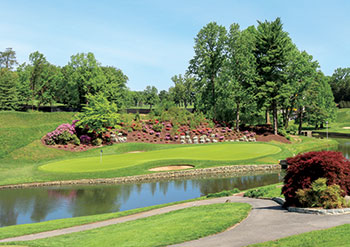
The 16th hole at Columbia Country Club plays at a beautiful 152 yards. (Photo: Columbia CC)
If McCormick’s 2019 is like last year, he will welcome anything he can add to his arsenal.
“Columbia is an old-school club, with the layout being largely the same as it was in 1910 when it was constructed,” McCormick says. “We are the only Washington, D.C.-metro private club that still maintains ryegrass fairways and Poa annua greens. Those Poa greens are amazing,” he says proudly. “We are about as far south as you get and still maintain Poa greens.”
Columbia Country Club is a by-invitation, members-only club. The design is a beautiful, rolling topography for players. There have been no significant changes to the length of the course.
McCormick, who hails from Peoria, Ill., holds a bachelor’s degree in plant and soil science from Southern Illinois University. He worked in St. Louis for five years at Greenbriar Hills Country Club and spent another year at Bellerive Country Club.
“I would say that disease and weather conditions have actually remained fairly consistent in the 16 years I’ve been here,” McCormick says of the course he runs in the humid mid-Atlantic region. “There is always high disease pressure in July and August.”
To keep the turf as healthy as possible, the fertility program gets its start in late October with a once-a-year application of granular fertilizer. Typically, McCormick will apply LebanonTurf’s Country Club fertilizer with a 21-0-18 or similar analysis. The material, which utilizes Meth-Ex high-activity nitrogen, is available in several formulations.
“That’s the only granular we use,” McCormick explains. The rest of the year, he supplements with urea, spoon feeding as needed. “We do not use any preemergence herbicide materials on our fairways or greens,” McCormick continues. Rather, they apply a broadleaf control and use Acclaim and Pylex for bermudagrass and goosegrass control. Goosegrass is a real problem at Columbia, and he finds Pylex knocks it out quite well. Still, the crew will do a postemergence or spot treatment to take care of any persistent issues with weeds. Acclaim also works on goosegrass (as well as crabgrass). It is a foliage-absorbed systemic that is rainfast in one hour.
Columbia has been in operation for more than 100 years, so the fertility is fairly established. McCormick has found no need to apply limestone to sweeten the soil, which is deep and loose.
The result is a premium playing experience for members, maintained by a staff of 26 people, including summer and seasonal help.
With the course and agronomic program established, there has not been a great deal of modification required at Columbia CC. The club recently renovated No. 2, installing a new bunker and tee complex.
And No. 14 was redone in the spirit of the existing course. The layout plays at 6,600 yards, and anyone golfing Columbia CC can’t help but look up and around at the surrounding area. It’s an oasis just outside the bustle of Washington, D.C.
“People particularly love the vistas we have,” McCormick says of the surrounds on each of the 18 holes. And McCormick loves the turf underfoot that is disease — and weed — free.









